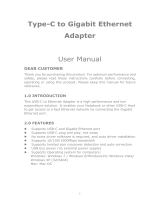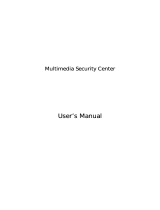
5
A750 Wireless Dual Band Gigabit Router JR6150
Chapter 8 Advanced Settings
Advanced Wireless Settings. . . . . . . . . . . . . . . . . . . . . . . . . . . . . . . . . . .107
Control the Wireless Radio . . . . . . . . . . . . . . . . . . . . . . . . . . . . . . . . . .107
Set Up a Wireless Schedule . . . . . . . . . . . . . . . . . . . . . . . . . . . . . . . . .108
View or Change WPS Settings . . . . . . . . . . . . . . . . . . . . . . . . . . . . . . .109
Set Up a Wireless Access List by MAC Address . . . . . . . . . . . . . . . . .110
Wireless AP . . . . . . . . . . . . . . . . . . . . . . . . . . . . . . . . . . . . . . . . . . . . . . .112
Wireless Repeating Function . . . . . . . . . . . . . . . . . . . . . . . . . . . . . . . . . .114
Set Up the Base Station . . . . . . . . . . . . . . . . . . . . . . . . . . . . . . . . . . . .115
Set Up a Repeater . . . . . . . . . . . . . . . . . . . . . . . . . . . . . . . . . . . . . . . .116
Port Forwarding and Port Triggering Configuration Concepts . . . . . . . . .118
Remote Computer Access Basics . . . . . . . . . . . . . . . . . . . . . . . . . . . .118
Port Triggering to Open Incoming Ports . . . . . . . . . . . . . . . . . . . . . . . .120
Port Forwarding to Permit External Host Communications . . . . . . . . .121
How Port Forwarding Differs from Port Triggering . . . . . . . . . . . . . . . .122
Set Up Port Forwarding to Local Servers . . . . . . . . . . . . . . . . . . . . . . . . .122
Add a Custom Service . . . . . . . . . . . . . . . . . . . . . . . . . . . . . . . . . . . . .123
Edit or Delete a Port Forwarding Entry . . . . . . . . . . . . . . . . . . . . . . . . .125
Application Example: Make a Local Web Server Public . . . . . . . . . . . .126
Set Up Port Triggering . . . . . . . . . . . . . . . . . . . . . . . . . . . . . . . . . . . . . . .127
Dynamic DNS . . . . . . . . . . . . . . . . . . . . . . . . . . . . . . . . . . . . . . . . . . . . . .131
Static Routes . . . . . . . . . . . . . . . . . . . . . . . . . . . . . . . . . . . . . . . . . . . . . .132
Remote Management . . . . . . . . . . . . . . . . . . . . . . . . . . . . . . . . . . . . . . . .136
Universal Plug and Play . . . . . . . . . . . . . . . . . . . . . . . . . . . . . . . . . . . . . .138
Traffic Meter . . . . . . . . . . . . . . . . . . . . . . . . . . . . . . . . . . . . . . . . . . . . . . .139
Chapter 9 Troubleshooting
Quick Tips. . . . . . . . . . . . . . . . . . . . . . . . . . . . . . . . . . . . . . . . . . . . . . . . .144
Sequence to Restart Your Network . . . . . . . . . . . . . . . . . . . . . . . . . . .144
Check Ethernet Cable Connections . . . . . . . . . . . . . . . . . . . . . . . . . . .144
Wireless Settings . . . . . . . . . . . . . . . . . . . . . . . . . . . . . . . . . . . . . . . . .144
Network Settings. . . . . . . . . . . . . . . . . . . . . . . . . . . . . . . . . . . . . . . . . .144
Troubleshooting with the LEDs. . . . . . . . . . . . . . . . . . . . . . . . . . . . . . . . .145
Power/Check LED Is Off or Blinking . . . . . . . . . . . . . . . . . . . . . . . . . . .145
Power/Check LED Stays Amber. . . . . . . . . . . . . . . . . . . . . . . . . . . . . .145
LEDs Never Turn Off . . . . . . . . . . . . . . . . . . . . . . . . . . . . . . . . . . . . . .146
Internet or Ethernet LAN Port LEDs Are Off . . . . . . . . . . . . . . . . . . . . .146
Wireless LEDs Are Off . . . . . . . . . . . . . . . . . . . . . . . . . . . . . . . . . . . . .146
WPS/FastLane Button Blinks Amber . . . . . . . . . . . . . . . . . . . . . . . . . .146
Cannot Log In to the Router . . . . . . . . . . . . . . . . . . . . . . . . . . . . . . . . . . .147
Cannot Access the Internet . . . . . . . . . . . . . . . . . . . . . . . . . . . . . . . . . . .147
Troubleshooting PPPoE . . . . . . . . . . . . . . . . . . . . . . . . . . . . . . . . . . . .149
Troubleshooting Internet Browsing . . . . . . . . . . . . . . . . . . . . . . . . . . . .149
Changes Not Saved . . . . . . . . . . . . . . . . . . . . . . . . . . . . . . . . . . . . . . . . .150
Wireless Connectivity . . . . . . . . . . . . . . . . . . . . . . . . . . . . . . . . . . . . . . . .150
Restore the Factory Settings and Password . . . . . . . . . . . . . . . . . . . . . .151
Troubleshoot Your Network Using the Ping Utility . . . . . . . . . . . . . . . . . .151
























